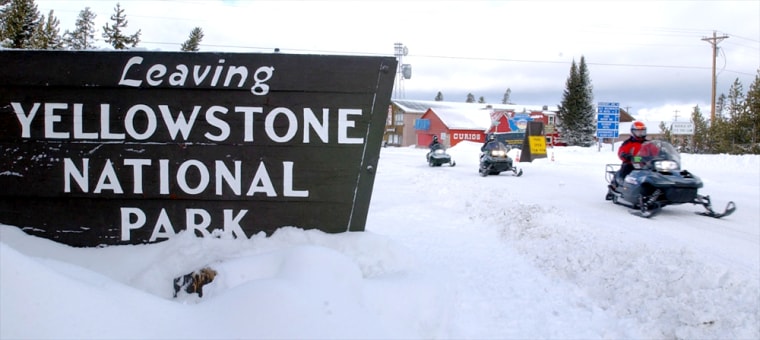Randy Roberson figured he would get a permit to guide trips into Yellowstone National Park this winter, and invested $310,000 in new snowmobiles that would meet the park’s new pollution requirements.
But a federal judge’s ruling this week essentially banned snowmobiles from the park, and Roberson is worried about his bottom line.
“You spend six months getting ready to do business a certain way, and this changes everything,” he said.
The National Park Service and business owners had planned for the season under rules approved this year and expected to go into effect Wednesday morning.
The rules had called for limiting the number and types of snowmobiles allowed in Yellowstone and Grand Teton national parks and the parkway connecting them. It was aimed largely at curbing air and noise pollution, and park officials considered it a balance between virtually unfettered snowmobile access and an all-out ban.
But on Tuesday, U.S. District Judge Emmet Sullivan in Washington, D.C., ordered the Park Service to revert back to a Clinton-era plan that called for a gradual phase-out of snowmobiles in favor of mass-transit snowcoaches.
Interior Secretary Gale Norton criticized the ruling, stating that "
Sullivan ruled the Bush administration had made an abrupt turnaround from the earlier plan, which intended to protect the park from pollution, without sound reasons. His decision means the number of snowmobiles allowed in Yellowstone every day will be 493, instead of 950.
It also means this could be the last season for snowmobiles in the park. Snowmobiling has been allowed for 40 years. But next winter, under the plan Sullivan ordered reinstated, only snow coaches would be allowed.
The International Snowmobile Manufacturers Association and BlueRibbon Coalition, an alliance of off-road vehicle enthusiasts, filed a request Wednesday for a stay of Sullivan’s decision, saying it would prevent thousands of visitors from seeing Yellowstone and would devastate local economies. Sullivan said he would take written arguments.
“The fight’s not over,” said Bill Dart, public lands director with BlueRibbon Coalition.
Business and tourism officials said they aren’t giving up on the season, despite Wednesday’s messy beginning.
Some snowmobilers who booked reservations to ride in the park independently were turned back from the gate. Park officials said that under the new plan, all snowmobiles entering Yellowstone must be part of a commercially guide trip.
Yellowstone spokeswoman Cheryl Matthews said visitors with advance reservations were being given other options. “We’re trying to work with them, to link them with guides or snowcoaches and tell them about trails outside the park,” she said.
The group argued that unacceptable pollution and health risks to workers would have continued even with the new emission and entry limits on snowmobiles.
But Norton called the proposed rule “a common sense solution to years of conflict. This rule allows Yellowstone employees to closely manage snowmobile use in ways that protect wildlife and resources while maintaining a quality visitor experience.”
“The plan discounts the extreme and unacceptable options — a complete ban on snowmobiles versus unrestricted access and continued reliance on older and polluting technology,” she said in a statement this week.
But the judge wrote that “the prospect of new technology is not ’new,”’ noting that less-polluting machines were considered and rejected when the Clinton administration was deciding how to reduce the harmful effects of snowmobiling.
In August, the Park Service asked for comments on two different ways to test snowmobile emissions and, in the final regulations, chose a method that was based on tests of entire classes of snowmobile engines.
The Park Service said more than 90 percent of the nearly 105,000 people who submitted comments on the new rules were against them, and snowmobile opponents said the Park Service was ignoring evidence.
“Never before has the National Park Service ... understood so completely what is needed to protect park resources, only to have political appointees at the Interior Department order a different course which they know will harm the park,” said Rick Smith, a retired Park Service official.
But some local businessmen remained upset by the ruling.
David McCray, who has a snowmobile rental company in West Yellowstone, said he had invested heavily in the cleaner snowmobiles because he thought his business needed them. But he said he never would have done so if the case had been decided earlier this fall. “For the judge to throw this out at the 12th hour is unconscionable,” he said.
